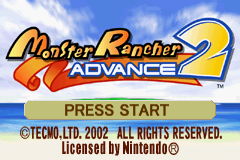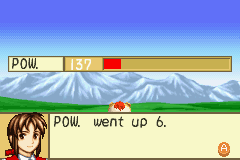The Monster Rancher
series, whilst not widely popular, has a very loyal cult following. This is for
a good reason; the games offer much depth in their design, allowing players to
breed their own monsters from the ground up, and control its development
throughout the game. Monster Rancher
Advance 2 is no exception in this monster-raising series, offering a deep,
tight role-playing simulation experience that proves to be rewarding and
satisfying.
The premise of the game is that you play a rookie breeder -
who is supposed to be you – who must breed a monster to fight in various
championships hosted by the monster-breeding company, AGIMA. Luckily, you don’t
have to go it alone and you are accompanied by your assistant, Holly, who is on
hand to help you with any breeding questions you may have and essentially acts
as your guide, telling you what mood or state your monster is in. What is
unique about the game is the method in which monsters are created. Visiting the
Shrine area in the Town Square will prompt you to input a number of random
characters on-screen, which will subsequently create your monster based on the
letters, numbers or symbols you used. This proves to be a fun experience as you
never know what monster will appear, especially surprising beginners to the
games. Another good feature is that you are not stuck with that monster on the
first attempt; you can keep inputting characters until you produce a monster
that suits you. Now, your monster will start off as a Rank E monster and it is
through fighting in tournaments that they are able to progress in rank as well
as progression in your Breeder Level. Increasing your Breeder Level means you
can train monsters that were previously inaccessible to you and raising their
rank drives the game’s narrative forward and also allows the player to fight in
higher-ranking tournaments. Rank progression is fairly straightforward which is
a good thing so players new to the series will easily be able to understand the
concept but, at the same time, it will take much work to train your monster to
be able to progress through the game.
The game offers the player a selection of methods in which
to train and develop their monsters. The first and most obvious of these
choices is to train your monster yourself in different areas i.e. Power,
Intelligence, Speed, Defence and the like which will subsequently raise its
stats in the desired area – however, should the monster be too tired or
fatigued, the training session could prove to be a failure which opens the
option of either scolding it or leaving it be. Another more effective method
lies in assigning your monster coaches for the fields in which you want it to
develop; some are more effective in certain fields than others, but generally
your monster’s stats are raised higher in these sessions than they would if
they trained independently. Of course, monsters will also gain experience in
actually fighting in tournaments, not only raising their popularity in the
in-game world but also significantly raising their stats. Offering the player
such a wide selection of ways to develop their monster is an admirable addition
and makes things more exciting than seeing the same old training animations
take place over and over again. This takes us onto monster battles in the game.
Once you feel like your monster is up to snuff, you can pit its strength and
skill in monster tournaments by choosing events off the in-game event calendar.
As expected, battles offer the monster the chance to perform moves it has
learned through its training; these are executed by waiting for the indicator
to hover over your monster’s skills and essentially taking in turns to execute
them against the enemy monster. The skills that are displayed in battle are the
ones the player equips their monsters with on their creature’s status screen
and more can be learned through training and sparring with a coach. Overall,
battles are very satisfying and can prove to be one of the game’s most
addictive features, allowing your monster to show off the results of its
training and often being intense, heated moments in later stages of the
competitions.
Where the game fails though, is offering a decent narrative.
It’s true that, as you progress through the competitions, you will encounter
various animé-styled characters that drive certain events forward that act as a
mini-narrative, if you will. Players who are huge fans of the Pokémon series
and who like a decent narrative to unfold amongst their hours of
monster-training and battling won’t be impressed by what story this game has to
offer. Characterisation is generally quite bland so the NPCs do little to save
what little of a story the game possesses. At the very least, the game
establishes its own fictional universe pretty well and references events from
previous games so Monster Rancher veterans
will feel right at home in that respect.
Overall, Monster
Rancher Advance 2 is fine monster-simulation/RPG hybrid that has the
potential to draw in the right player. Armed with an in-depth monster-breeding
system and addictive battling, players looking for an intelligent and gripping
monster-breeding simulator could very well start looking here. The numerous
amounts of monster possibilities means a vast potential for replay value and
the huge number of tournaments contribute to the game’s healthy lifespan. It
won’t satisfy all players, but for those in search of an in-depth
monster-breeding experience, this is the game for you.











